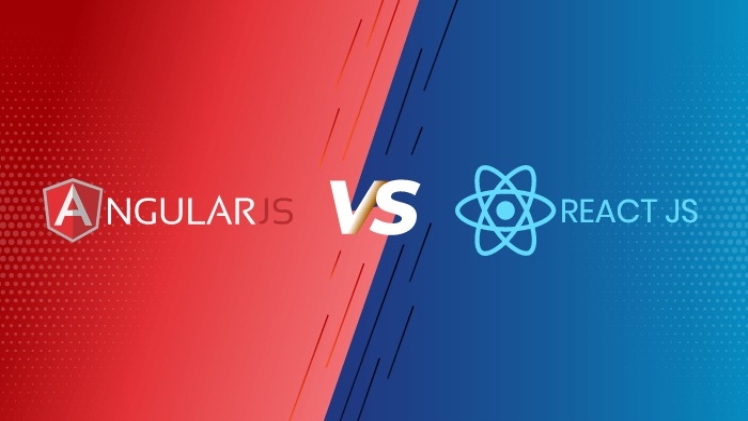In the ever-changing world of web development, selecting the appropriate JavaScript framework may make or break your project. Popular choices include AngularJS and ReactJS. Both Google and Facebook’s frameworks are popular for constructing dynamic and responsive web apps. However, project-specific criteria must be considered while choosing Angular or ReactJS.
This detailed blog will compare AngularJS vs ReactJS, outlining their pros and cons, to help you choose the best Angular or ReactJS Development Services in USA for your development requirements. Working with a skilled development business may boost project success.
AngularJS: A Deep Dive
In 2010, Google introduced AngularJS, often known as Angular 1. This sophisticated JavaScript framework lets developers construct massive, feature-rich online apps.
Here are some AngularJS highlights:
Two-way Data Binding:
AngularJS robust binding automatically updates the view when the model changes. This functionality simplifies development.
Modular Architecture:
AngularJS promotes reusable and modular components. It manages application components via Dependency Injection, making maintenance and scaling simpler.
HTML Templates:
AngularJS use declarative HTML templates with unique properties. Developers may easily define the app’s user interface using this method.
Built-in Directives:
AngularJS offers directives for tasks like data binding, form validation, and routing.
Testing:
AngularJS prioritizes testability. It supports Dependency Injection and end-to-end testing.
ReactJS: A Deep Dive
ReactJS, established by Facebook and open-sourced in 2013, is another prominent JavaScript user interface framework. ReactJS focuses on the view layer, although it may be used with other frameworks and tools to develop online apps.
Here are some ReactJS highlights:
Virtual DOM:
Using a virtual DOM in ReactJS improves performance by minimizing direct manipulation of the actual DOM. Updates and rendering are efficient using this method.
Component-Based:
React promotes application development using reusable components. Complex user interfaces are straightforward to develop since each component handles its state.
Unidirectional Data Flow:
React uses a one-way data flow, directing updates from parent to child components. Debugging and understanding application behaviour are easier.
JSX:
React utilizes JSX to control component structure and appearance in JavaScript code. This method lets developers construct component templates in HTML syntax.
Ecosystem:
React has a robust ecosystem of third-party libraries and utilities, including Redux for state management and React Router for routing.
Comparing AngularJS and ReactJS
After reviewing AngularJS and ReactJS’s main features, let’s compare them in several ways:
Performance:
AngularJS:
- Two-way data binding can sometimes lead to performance issues in large applications.
- Updates the entire DOM when changes occur, which may be less efficient.
ReactJS:
- The virtual DOM significantly enhances performance by reducing direct DOM manipulation.
- Allows for fine-grained control over updates, making it highly efficient.
Learning Curve:
AngularJS:
- Has a steeper learning curve, especially for developers new to the framework.
- Requires understanding of complex concepts like Dependency Injection.
ReactJS:
- Has a more straightforward learning curve, as it primarily focuses on the view layer.
- The use of JSX makes it easier for developers familiar with HTML.
Community and Ecosystem:
AngularJS:
- The community and ecosystem have declined recently due to the shift to Angular (Angular 2+).
- Limited availability of third-party libraries and tools compared to React.
ReactJS:
- Enjoys a vast and active community with continuous growth.
- The abundance of third-party libraries and tools makes it versatile for various applications.
Scalability:
AngularJS:
- Suitable for large-scale applications, thanks to its modular architecture and Dependency Injection.
- Offers built-in solutions for routing and form handling.
ReactJS:
- It is well-suited for building scalable applications thanks to its component-based structure.
- Requires integrating third-party libraries for routing and state management (e.g., React Router and Redux).
Flexibility:
AngularJS:
- Prescribes a more opinionated structure for applications.
- Offers a comprehensive set of built-in features but can lead to a bloated codebase.
ReactJS:
- Provides greater flexibility, allowing developers to choose the tools and libraries that best suit their needs.
- Encourages a minimalist approach, resulting in more lightweight code.
Community Support:
AngularJS:
- Official support for AngularJS has ended, and it’s recommended to migrate to Angular (Angular 2+).
- Limited updates and security patches.
ReactJS:
- Continuously updated and actively supported by Facebook and the open-source community.
- Regularly receives updates and security patches.
Development Tools:
AngularJS:
- Offers a comprehensive development environment with tools like Angular CLI.
- Provides end-to-end testing and debugging support.
ReactJS:
- Lacks a built-in CLI, but developers can choose from various tools like Create React App.
- Offers a rich ecosystem of third-party development tools.
Use Cases:
AngularJS:
- Well-suited for complex, data-heavy applications, such as enterprise dashboards and management systems.
- It is a good choice when you need built-in features like routing and form handling.
ReactJS:
- Ideal for building user interfaces in applications where performance and reusability are essential.
- Widely used in single-page applications (SPAs) and interactive web applications.
Choosing the Right Framework
Project requirements determine whether to use AngularJS or ReactJS. Guidelines for informed decision-making:
Project Complexity:
- If you are working on a relatively simple project with a small team, ReactJS may be the more straightforward choice.
- For large, complex applications with a focus on modularity and data management, AngularJS might be a better fit.
Performance Requirements:
- If your project demands high performance and efficient updates, ReactJS, with its virtual DOM, is the preferred option.
- For applications where performance is not a critical factor, AngularJS can be a viable choice.
Community and Support:
- Consider the availability of resources, documentation, and third-party libraries. ReactJS has a larger and more active community.
- AngularJS, with its dwindling support, may need help finding help and resources.
Scalability and Flexibility:
- Assess your scalability needs and how much flexibility you require in your project.
- ReactJS provides greater flexibility and can be tailored to your requirements, while AngularJS offers a structured approach.
Long-Term Viability:
- Think about the long-term viability of the framework. ReactJS has a more promising future, while AngularJS is primarily considered a legacy.
Developer Familiarity:
- Consider the skills and familiarity of your development team. If your team has expertise in a particular framework, it might influence your choice.
Leveraging an Expert Development Company
Whether you use AngularJS or ReactJS, working with a skilled Reactjs development company in USA can boost project success. How such a relationship may help your project:
Technical knowledge:
Professional development firms have teams with diverse technology knowledge. They can assist you in choosing the best framework for your project.
Efficiency:
These organizations can expedite development, assuring on-time and budget project completion.
Quality Assurance:
Expert teams follow the best standards in coding, testing, and security. A high-quality product is assured.
Scalability:
They develop applications to accommodate growing user bases and feature sets.
Maintenance and assistance:
Professional development firms provide continuing assistance to keep your application safe and up-to-date after the project.
Conclusion
The AngularJS vs. ReactJS argument has no clear winner. Your project’s needs, the team’s framework knowledge, and long-term ambitions determine the option. Modern web developers generally use ReactJS for its performance and community. It may be a good option if you hire AngularJS Development services in USA or ReactJS Development Services in USA that match your project abilities. An experienced development business can help you make the optimal selection for your project, guaranteeing its success in a competitive digital world.

